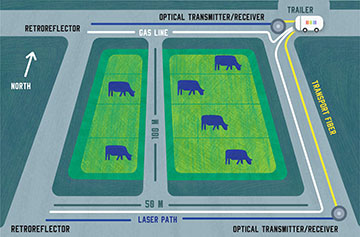
The agricomb setup identifies trace gases as comb light is sent back and forth across open-air paths in a cattle feedlot. [Image: N. Hanacek/NIST]
Planes, trains and automobiles seem to bear the brunt of the blame when considering human-made sources of the heat-trapping greenhouse gases that contribute to global warming. However, when it comes to methane emissions, transportation isn’t the main culprit—it’s agriculture.
Now, researchers at the National Institute of Standards and Technology (NIST) and Kansas State University, USA, have developed a dual-comb spectroscopy system for sensing gas emissions down on the farm (Sci. Adv., doi: 10.1126/sciadv.abe9765). The so-called agricomb is reportedly the first device to leverage frequency comb technology in an agricultural setting—an effort that could help optimize agricultural processes to minimize heat-trapping greenhouse-gas production.
Combing light
Optical frequency combs act as rulers for light, measuring discrete colors or frequencies to enable precision measurement for various applications. The ultra-precise technology, which enables atomic clocks so accurate that they would only lose or gain a few seconds over the age of the universe, has inspired many spinoffs in the two decades since it was first conceived, including astrocombs for discovering Earth-like planets.
In the current work, the NIST and KSU team spun off a new kind of system—the agricomb. The portable two-comb apparatus sends light back and forth across 100-m open-air paths in a cattle feedlot containing around 300 cows. It works by sensing trace gases based on the amounts of infrared light absorbed by the atmosphere.
Emissions solutions
The researchers outfitted the system to target specific emissions from livestock—which in the United States are considered to be the largest source of anthropogenic methane as well as a significant producer of ammonia (an atmospheric pollutant). Although it’s known that livestock, particularly cattle, are major culprits in greenhouse-gas emissions, it can be difficult to quantify these emissions, as they vary broadly based on what the animals eat and how the farm is managed.
Enter dual-comb spectroscopy (DCS), a clever method in which two frequency combs interfere to generate high-resolution, broadband spectra, without external calibration. Already a promising technique for determining greenhouse-gas emissions in the oil and urban sectors, the researchers behind the new work proposed to take open-path dual-comb spectroscopy to the farm.
The agricomb system covers 35 THz from 1.4 µm to 1.7 µm with frequency combs able to resolve the atmospheric transmission across more than 175,000 comb teeth. It was designed, the researchers write, to target multispecies feedlot gas emissions at a laboratory level while conveniently stationed in the field.
With this setup, the team performed upwind and downwind measurements of emissions from the cows themselves as well as from the cow manure, reportedly acquiring the broadest spectrum ever captured with atmospheric open-path DCS.
Toward precision agriculture
To validate their technique, the researchers compared their results against those of a standard agricultural method—a closed-path cavity ring-down spectroscopy (CRDS) gas analyzer. The results reportedly agreed to within 6%, and DCS’s precision actually edged ahead of CRDS in the downwind channel.
These results demonstrate for the first time, the researchers write, the advantages of broadband, high-resolution laser sensing for quantifying agricultural emissions—achieving sub-parts per million detection sensitivity for ammonia and parts per million sensitivity for methane. Furthermore, they say, the DCS method should allow for precise emissions estimation in larger pasture systems with sparsely distributed cows. For these reasons, the team believes its agricomb could contribute to the future of precision agriculture and enable more sustainable and productive farms.
While this system operated in the near-infrared range, the team is interested in advancing further into the mid-infrared, which would allow for the quantification of even more gasses with greater sensitivity.
